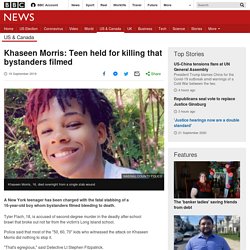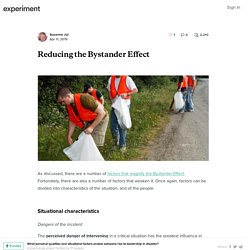

One would think that with a greater number of onlookers, there would likely be a higher chance of at least one person coming forward to help with an emergency. Ironically, it is due to the bystander effect that in the end it may be that nobody comes out to help at all because of the diffusion of responsibility and pluralistic ignorance.
Fortunately, not all is lost as there are things both onlookers and the one in need of help can do in order to mitigate the issue of inaction caused by the bystander effect.
What Is the Bystander Effect? What Is the Bystander Effect? If you witnessed an emergency happening right before your eyes, you would certainly take some sort of action to help the person in trouble, right?

While we might all like to believe that this is true, psychologists suggest that whether or not you intervene might depend upon the number of other witnesses present. Diffusion of Responsibility. Pluralistic Ignorance. Kitty Genovese. How The Murder Of Kitty Genovese Created The Bystander Effect. Wikimedia CommonsKitty Genovese whose muder would inspire the psychological phenomenon known as the bystander effect.

At approximately 3:15 a.m. on March 13, 1964, a woman was murdered. Her name was Kitty Genovese. She was 28 years old, “self-assured beyond her years,” and had a “sunny disposition.” However, on that Friday evening, none of that mattered. As Kitty Genovese was stabbed to death in an alleyway outside her home, the friends and neighbors she had lived next to for several years stood by, choosing not to get involved as she lay there dying. Around 2:30 a.m. on the night of her attack, Kitty Genovese left the bar she worked at and headed for home.
A few minutes after she left, she stopped at a traffic light. At 3:15, Genovese pulled into the parking lot of the Kew Gardens Long Island Rail Road station parking lot, which was about 100 feet from her front door. Getty ImagesKitty at work at Ev’s bar. Upon being stabbed, Genovese screamed, running toward her home. 2009 Richmond High School gang rape. Police: Up to 20 people saw gang rape - US news - Crime & courts. RICHMOND, Calif. — The gang rape and beating of a 15-year-old girl on school grounds after her homecoming dance was horrific enough.

But even more shocking, police say, was that up to 20 people watched and did nothing to stop it. The attack over the weekend rattled this crime-ridden city of 120,000 in the San Francisco Bay area, where one police official called it one of the most heinous crimes he has ever seen. Some students have already left the school district in response to the attack. "It's not safe there at all," said 16-year-old Jennie Steinberg, whose mother let her transfer out of the district Tuesday.
"I'm not going back. " The victim, a sophomore, had left the dance and was drinking in a school courtyard with a group of students when she was attacked, police said. Two suspects were in custody Monday, but police said as many as five others ranging in age from 15 to mid-20s attacked the girl for more than two hours at a dimly lit area near benches Saturday night. Khaseen Morris. Khaseen Morris: Teen held for killing that bystanders filmed.
Image copyright Nassau County Police A New York teenager has been charged with the fatal stabbing of a 16-year-old boy whom bystanders filmed bleeding to death.

Tyler Flach, 18, is accused of second-degree murder in the deadly after-school brawl that broke out not far from the victim's Long Island school. Police said that most of the "50, 60, 70" kids who witnessed the attack on Khaseen Morris did nothing to stop it. "That's egregious," said Detective Lt Stephen Fitzpatrick. "Kids stood here and didn't help Khaseen," Lt Fitzpatrick said.
Police were called to a row of shops near Oceanside High School in Nassau County on Monday afternoon. Mr Fitzpatrick said the fight, which took place outside a pizzeria, was a "pre-arranged dispute" over a girl. Police say the main suspect and six or seven other assailants charged at Khaseen, who was unarmed. As the one seeking help. As the bystander. Reducing the Bystander Effect. As discussed, there are a number of factors that magnify the Bystander Effect.

Fortunately, there are also a number of factors that weaken it. Once again, factors can be divided into characteristics of the situation, and of the people. Situational characteristics. How to Overcome the Bystander Effect. Psychologists have long been interested in exactly why and when we help other people.

There has also been a tremendous amount of interest in the reasons why we sometimes don't help others. The bystander effect is a social phenomenon that occurs when people fail to help those in need due to the presence of other people. In many cases, people feel that since there are other people around, surely someone else will leap into action.1 While the bystander effect can have a negative impact on prosocial behavior, altruism and heroism, researchers have identified a number of different factors that can help people overcome this tendency and increase the likelihood that they will engage in helping behaviors.2 Some of these include: Witnessing Helping Behavior Sometimes just seeing other people doing something kind or helpful makes us more willing to help others.
Imagine that you are walking into a large department store. Being Observant Being Skilled and Knowledgeable Guilt Feeling Good.